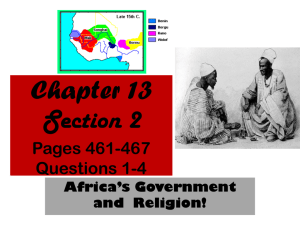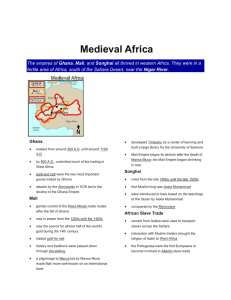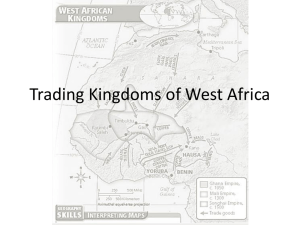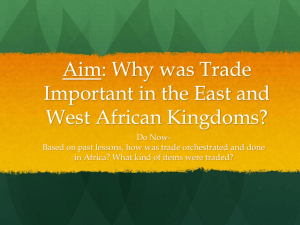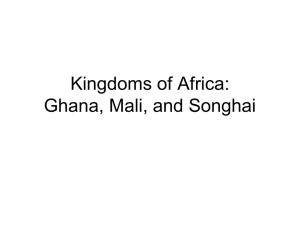Kingdom and States of Africa - Mater Academy Lakes High School
advertisement
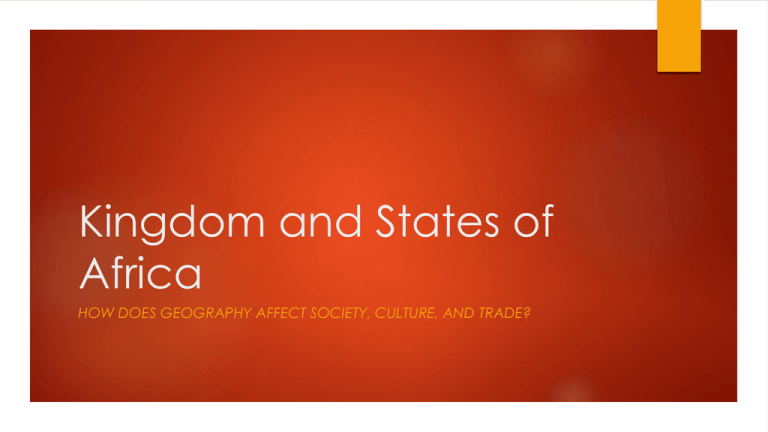
Kingdom and States of Africa HOW DOES GEOGRAPHY AFFECT SOCIETY, CULTURE, AND TRADE? The Kingdom of Ghana Guiding Question: How did gold help create a strong economy in the kingdom of Ghana? • Ghana, the first great trading state in West Africa, emerged as early as A.D. 500. • The kingdom of Ghana was located in the upper Niger River valley, a grassland region between the Sahara and the tropical forests along the West African coast. • (The modern state of Ghana, located in the forest region to the south, takes its name from this early state.) • Most people in the area were farmers living in villages under the authority of a local ruler. • Together, the villages made up the kingdom of Ghana. • The people of Ghana had lived off the land for centuries. • They prospered from their abundant supply of iron ore. • The blacksmiths of Ghana were valued because of their ability to turn this ore into tools and weapons. Ghana also had an abundance of gold. • The heartland of the state was located near one of the richest gold-producing areas in all of Africa. • Ghana's gold made it the center of an enormous trade empire. Muslim merchants from North Africa brought to Ghana metal goods, textiles, horses, and salt. • Salt was a highly desired item for the Ghanaians. • It was used to preserve food and to improve food's taste. • Salt was also important because people needed extra salt to replace what their bodies lost in the hot climate. • Ghanaians traded their abundant gold for products brought from North Africa. • Other Ghanaian exports, including ivory, hides, and slaves, were carried to the markets of the Mediterranean and beyond. • Berbers, nomadic peoples whose camel caravans became known as the "fleets of the desert," carried much of the trade across the desert. • Camels were a crucial factor in trans-Saharan trade. • They were well-adapted to desert conditions and could drink large quantities of water at one time. As many as 100 camels would be loaded with goods and supplies for a typical caravan trek. • Accompanied by guards, the caravan moved at a rate of about three miles (4.8 km) per hour. • A caravan might take 40 to 60 days to reach its destination. The trading merchants of Ghana often became wealthy. • Kings also prospered because they imposed taxes on goods that entered or left the kingdom. • By the eighth and ninth centuries, however, much of this trade was carried on by Muslim merchants. • They bought the goods from local traders, using iron or copper or items from as far away as Southwest Asia. • They then sold the goods to Berbers, who carried them across the desert. The Kingdom of Mali Guiding Question: What contributed to the success of the kingdom of Mali? • Ghana flourished for several hundred years. Weakened by wars, it collapsed during the 1100s. • In its place rose new trading states in West Africa. • The greatest was Mali, established in the mid-1200s by Sundiata Keita. • Considered the founder of his nation, Sundiata defeated Ghana and captured its capital in 1240. • He united the people of Mali and created a strong government. • Extending from the Atlantic coast inland to the famous trading city of, present-day Tombouctou, Mali built its wealth and power on the gold and salt trade. • Most of its people, however, were farmers who grew grains such as sorghum, millet, and rice. • The farmers lived in villages with local rulers, who served as both religious and administrative leaders. • The ruler was responsible for sending tax revenues from the village to the kings of Mali. • One of the richest and most powerful kings was Mansa Mūsā (mansa means “king”), who ruled from 1312 to 1337. • Mansa Mūsā doubled the size of the kingdom of Mali. He created a strong central government and divided the kingdom into provinces ruled by governors whom he appointed. • After he felt secure, he decided—as a devout Muslim—to make a pilgrimage to Makkah. • A king was no ordinary pilgrim. Thousands of servants and soldiers joined Mansa Mūsā on this journey. Hundreds of camels carrying gold, food, clothing, and supplies accompanied the people. • Everywhere he went, Mansa Mūsā lavished gold gifts on his hosts and bought hundreds of items with gold. • By putting so much gold into circulation in such a short time, he caused its value to fall. • The caravan’s route took it through Egypt, and one observer reported, “Gold was at a high price in Egypt until they came in that year. … its value fell and it cheapened in price and has remained cheap till now.” • No doubt, Mansa Mūsā's great pilgrimage left people with an image of him as a great ruler of a powerful and prosperous kingdom. • Mansa Mūsā also left another legacy. • Earlier rulers had already converted to Islam, but Mansa Mūsā was inspired to make Timbuktu a center of Islamic learning and culture. • In Timbuktu, he built mosques and libraries. He brought scholars to the city to study the Quran. The Kingdom of Songhai Guiding Question: What were the key factors in the kingdom of Songhai’s rise to power? • Like the Nile, the Niger River floods, providing a rich soil for raising crops and cattle. • East of Timbuktu, the Niger makes a wide bend. • The Songhai established themselves south of that river bend. In 1009 a ruler named Kossi converted to Islam and established the Dia dynasty. This first Songhai state benefited from the Muslim trade routes linking Arabia, North Africa, and West Africa. An era of prosperity ensued with Gao as the chief trade center. Under the leadership of Sunni Ali, who created a new Sunni dynasty in 1464, Songhai began to expand. Sunni Ali spent much of his reign on horseback and on the march as he led his army in one military campaign after another. His armies both defended Songhai territory from attacks by outsiders and conquered new territories.
